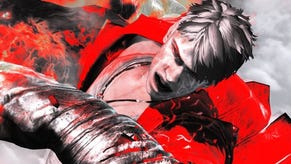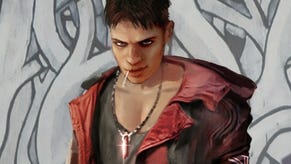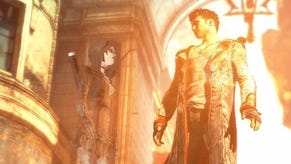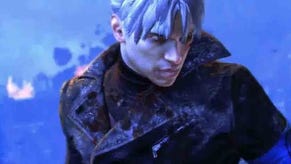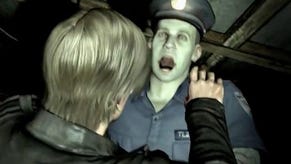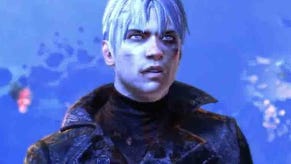DMC Devil May Cry
Platinum meddle.
The player can swap between Dante's angel, demon and human powers on the fly, mixing them up into wide number of possible attacks. "There's lots of breadth to the combat," says Antoniades, as that last of the locust-y enemies is dispatched with an extreme close-up, slow-mo flourish.
"In this incarnation, Dante is young and he's a lot less refined in his moves, more aggressive and brutal, more of a street fighter," he explains. This is certainly reflected in the soundtrack, which mixes an unintelligible angry growl over a thumping beat, which dynamically adapts to the action on-screen.
Switching from the street to what we're told is a secret area, a spectacular tower rises high above a sea at sunset, a scene constructed with Ninja Theory's keen eye for the epic. Here, as he enters a new battle arena, we see Dante's Devil Trigger in action.
Once engaged, his hair (oh god, not the hair again) turns white, enemies freeze in mid-air and Dante launches into a sequence of combos, each hit delivered with a thunderous bass effect.
Antoniades cites his DMC's love of air rage as the main point of difference in combat with earlier entries in the series. "A lot of the emphasis is on air combos, juggling," he says. "It's very skill based." And it does look awfully cool.
The game world itself is "malignant", Antoniades notes. "A malignant version of our world, like a sentient living world." Which means it can change to attack Dante, but he can also now manipulate the world himself.
A final section is demoed to highlight this. Dante sprints through a street, which crumbles, twists and compacts, trying to crush him. Seconds later he smashes through a stained-glass window and into a church. The female apparition appears again - the studio isn't saying who she is yet, just that she talks to Dante from the human world - to aid him, and after a further sequence of impressive, dramatic gymnastics against angry masonry, he escapes.
Joining The Hair on fans' list of grievances about the DMC reboot are concerns over the game's framerate. A series known for 60fps smoothness has moved to Unreal Engine 3 and what Ninja Theory is promising will be a "locked" 30fps: something Antionades admits was not achieved in the studio's previous release, the compelling Enslaved.
What the game loses in silky-smoothness, he claims it will make up for in other areas: notably the dramatic environmental changes on display in the demo.
Purists fear the drop in framerate may adversely affect the responsiveness of combat. On that note, we are told Ninja Theory is working very closely with the director of the previous DMC title to find "ways to replicate the feel of 60fps". The game will, we are assured, "feel like proper Devil May Cry when you have the controller in your hand."
At this stage, then, Ninja Theory has demonstrated the foundation for an exciting, stylish, over-the-top action game that offers a new twist on the core elements of the series, borne from the studio's significant experience in the genre.
Hands-off will hopefully soon become hands-on, where we'll get a clearer feel for the game, and - lest we forget - discover where one of the medium's most outstanding and accomplished visual storytellers takes this character and this universe. The Devil, it seems, is in the detail.


